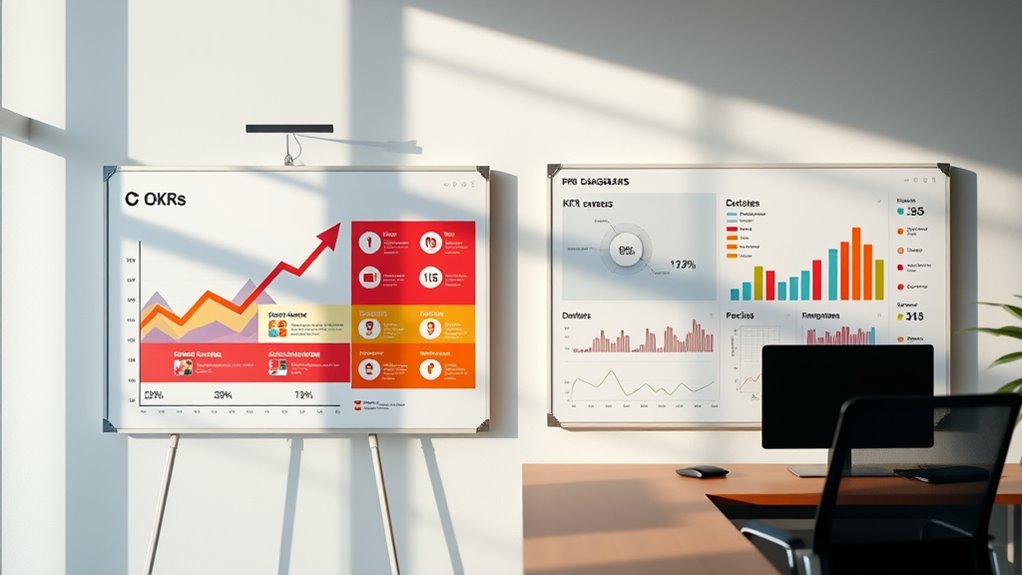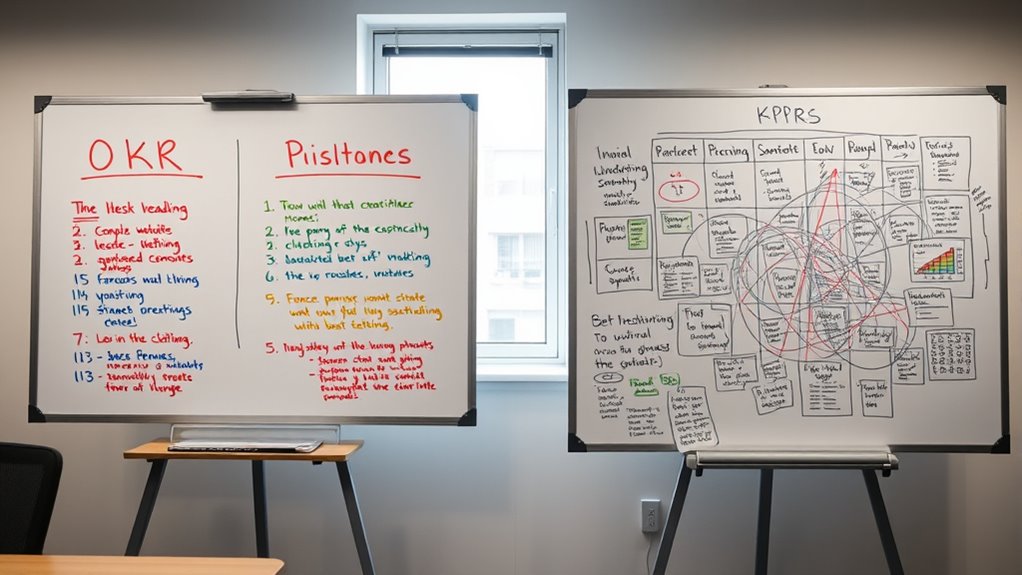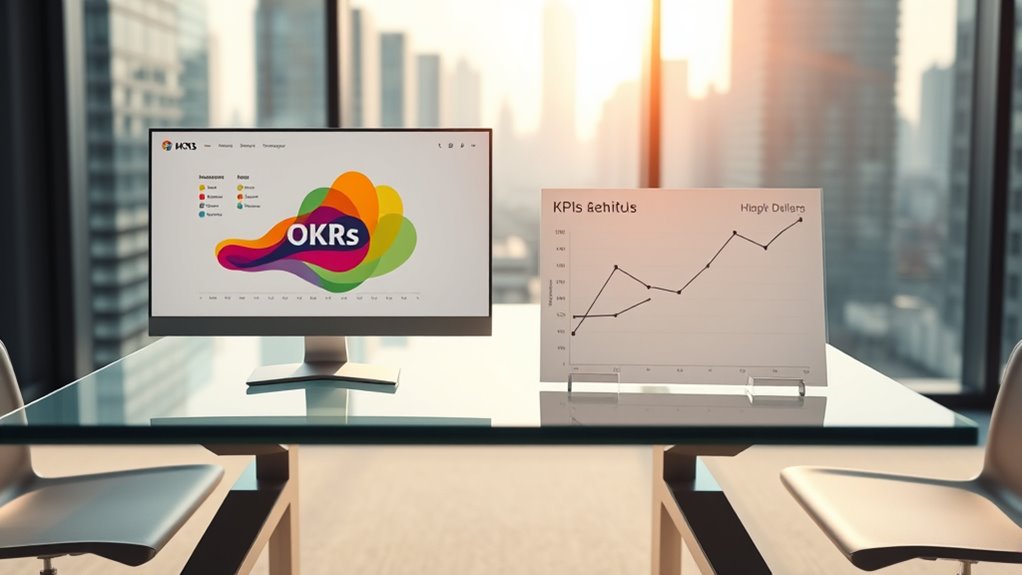OKRs (Objectives and Key Results) set ambitious goals to guide your team’s progress and align with your company’s strategy, focusing on growth and innovation. KPIs (Key Performance Indicators) track specific, measurable data points to monitor ongoing performance and operational efficiency. While OKRs inspire big-picture efforts, KPIs provide concrete benchmarks for success. If you want to understand how these tools work together to boost your organization, keep exploring the details ahead.
Key Takeaways
- OKRs focus on ambitious, strategic goals and future growth, while KPIs measure ongoing operational performance.
- OKRs promote innovation and alignment, whereas KPIs provide concrete data to monitor specific metrics.
- OKRs are set periodically to drive strategic initiatives; KPIs track real-time progress and stability.
- OKRs foster cross-department collaboration and shared purpose; KPIs support transparency through measurable benchmarks.
- Both tools complement each other by aligning strategic goals with performance metrics for continuous improvement.
Defining Objectives and Key Results

Have you ever wondered how teams set clear priorities and measure progress effectively? It all starts with goal setting—defining specific objectives that guide efforts. When you establish clear objectives, you create a foundation for success. To track progress, you need performance metrics that serve as benchmarks. These key results help you gauge whether you’re moving in the right direction. Additionally, aligning your goals with relevant performance metrics ensures that everyone understands what’s important. Establishing core personality traits can also influence how teams approach goal setting and accountability. Unlike vague intentions, well-defined objectives provide focus, while measurable key results offer concrete evidence of achievement. By aligning your goals with performance metrics such as KPIs, you ensure everyone understands what’s important. This clarity keeps teams motivated and accountable. Incorporating performance metrics like KPIs helps in monitoring progress objectively, while measurement techniques can help refine your approach and improve overall outcomes. Ultimately, effective goal setting combined with meaningful performance metrics creates a solid framework for achieving success and staying aligned with your organization’s priorities.
Clarifying Key Performance Indicators

Once you’ve established clear objectives and key results, the next step is to clarify what specific indicators will measure success. These are your performance metrics, providing concrete data to track progress. Clear KPIs help align your team’s effort with your goal setting process by offering measurable targets. When defining KPIs, focus on data points that directly reflect your objectives, ensuring they are specific, quantifiable, and relevant. Avoid vague metrics; instead, choose indicators that provide actionable insights. This clarity enables you to monitor performance consistently and make informed adjustments. By precisely defining KPIs, you create a solid foundation for evaluating whether your efforts are leading toward your desired outcomes, making your goal setting more effective and transparent. Additionally, understanding the best shampoos for highlighted hair can ensure that your hair remains vibrant and healthy while pursuing your goals. Being aware of safety features like auto shut-off in heated products can also help maintain safe usage practices. Recognizing security vulnerabilities and other risks in new payment technologies can further support your ability to implement effective risk management strategies. Incorporating knowledge of tableware materials and trends can also inspire more thoughtful choices in your personal or professional settings.
Purpose and Focus of OKRS Vs KPIS

You use OKRs to align your team’s goals with your company’s strategy, ensuring everyone works toward common objectives. KPIs, on the other hand, focus on measuring specific performance metrics to track progress and motivate improvement. Understanding their different purposes helps you choose the right tool for strategic focus and effective measurement. Additionally, performance metrics can help you stay ahead in setting relevant goals and benchmarks that drive growth.
Strategic Alignment Focus
While both OKRs and KPIs serve to guide organizational performance, they differ markedly in their strategic focus. OKRs are designed to align teams with broader innovation trends and future-oriented goals, encouraging aggressive growth and adaptability. They reflect a leadership style that emphasizes vision, agility, and continuous improvement. KPIs, on the other hand, focus on measuring ongoing operational performance, ensuring that day-to-day activities support existing strategies. They tend to align with leadership styles that prioritize stability, consistency, and efficiency. Your organization’s strategic alignment with OKRs fosters a proactive culture that seeks innovation and transformation, while KPIs reinforce a focus on maintaining steady progress within established frameworks. Wall organization systems can be incorporated into performance strategies to visually track progress and support goal achievement. Incorporating performance tracking tools can enhance visibility and accountability across teams, aligning with your strategic goals. Understanding this distinction helps you craft a performance approach that aligns with your leadership style and strategic ambitions, especially when considering performance measurement methods to ensure goal clarity and progress. Additionally, the use of performance benchmarks based on industry standards can help set realistic yet challenging targets that drive continuous improvement. Moreover, integrating drivetrain components like sensors and gear-shifting mechanisms into performance metrics can provide detailed insights into operational efficiency and adaptability.
Measurement and Motivation
Understanding how OKRs and KPIs measure and motivate performance reveals their distinct purposes. OKRs focus on setting ambitious goals that drive employee motivation and foster creative inspiration. They encourage you to think big and push boundaries, aligning personal efforts with company vision. KPIs, on the other hand, track specific metrics to monitor ongoing performance, providing clear benchmarks that keep you accountable. While KPIs offer measurable targets, they may lack the motivational spark that OKRs provide. Both tools influence performance, but OKRs often inspire innovation and engagement through their aspirational nature. Conversely, KPIs maintain focus and consistency, ensuring progress toward established objectives. Additionally, incorporating diverse designs and materials can enhance engagement and motivation within teams by fostering creativity and ownership. Recognizing the role of digital literacy in modern work environments can further improve how teams adapt to technological changes. Furthermore, understanding the importance of website performance metrics allows organizations to refine their strategies for better outcomes. Together, they shape a balanced approach to measurement and motivation within your organization.
How OKRs Drive Strategic Alignment

When you implement OKRs, you clarify your organization’s goals, making them clear and actionable. This focus helps your teams work toward common objectives and stay aligned. Additionally, OKRs encourage collaboration across different departments, ensuring everyone moves in the same strategic direction. Incorporating goal-setting strategies can further enhance the effectiveness of your alignment efforts. Moreover, utilizing performance metrics can provide measurable insights into progress and success.
Clarifies Organizational Goals
OKRs (Objectives and Key Results) help organizations clearly define their goals and guarantee everyone is aligned toward the same priorities. They foster a strong organizational culture by promoting transparency and accountability. Your leadership style influences how effectively OKRs are communicated and adopted. To clarify organizational goals, consider these points:
- Set clear, measurable objectives that reflect your company’s vision
- Ensure all teams understand how their goals support overall strategy
- Use OKRs to create a shared sense of purpose across departments
- Regularly review progress to adapt and maintain alignment
Enhances Team Focus
By setting clear objectives and measurable key results, you help your team stay laser-focused on the most impactful priorities. This clarity boosts team motivation, as everyone understands exactly what needs to be achieved and how their efforts contribute to larger goals. When objectives are aligned with strategic priorities, resource allocation becomes more efficient, ensuring time and effort are directed toward high-value activities. OKRs create a shared sense of purpose, reducing distractions and fostering accountability. As a result, your team can concentrate on tasks that truly matter, minimizing wasted effort. This heightened focus leads to better performance, faster progress, and a stronger sense of achievement, ultimately driving your organization’s success through disciplined, goal-oriented work.
Promotes Cross-Functional Collaboration
Because OKRs clearly define strategic priorities, they naturally foster collaboration across different teams. When everyone understands shared objectives, cross department collaboration becomes seamless, and goal alignment improves. This clarity encourages teams to work together toward common outcomes. To maximize this effect:
- Communicate OKRs company-wide to ensure everyone’s aligned.
- Set cross-functional goals that require input from multiple departments.
- Use regular check-ins to track progress and address misalignments.
- Celebrate collaborative successes to reinforce team cohesion.
The Role of KPIs in Performance Tracking

Have you ever wondered how organizations measure their progress toward specific goals? KPIs, or key performance indicators, play a essential role in this process. They serve as clear performance metrics that track how well your team is doing in real-time. By monitoring KPIs, you can identify areas needing improvement and make data-driven decisions. Data visualization helps you interpret this data quickly, highlighting trends and patterns at a glance. This visual approach makes complex information accessible and actionable, keeping everyone aligned on progress. KPIs provide concrete benchmarks, ensuring your efforts stay focused and measurable. Ultimately, they help you stay on course, evaluate success, and refine strategies to achieve organizational objectives efficiently.
Setting and Measuring OKRs

Setting and measuring OKRs involves clearly defining your objectives and key results to align your team’s efforts with organizational goals. To do this effectively, focus on the following:
- Identify specific innovation metrics that track progress on new initiatives or product development.
- Set measurable key results that directly impact customer satisfaction, such as improved service quality or response times.
- Regularly review progress to guarantee objectives stay relevant and achievable.
- Adjust key results based on feedback and changing priorities to maintain alignment and motivation.
Selecting and Monitoring KPIs

To effectively select and monitor KPIs, you need to identify the most relevant metrics that directly reflect your business objectives. Focus on KPIs that align with your sales strategies and enhance customer engagement. For sales, track indicators like conversion rates, average deal size, or sales growth to measure progress accurately. For customer engagement, monitor metrics such as customer satisfaction scores, retention rates, or website interaction levels. Regularly review these KPIs to spot trends and identify areas for improvement. Use dashboards or reporting tools to keep real-time visibility. By staying proactive with your monitoring, you can quickly adapt your strategies, ensuring your efforts drive the desired outcomes and support your overall business goals effectively.
Integration of OKRs and KPIs in Business Management

Integrating OKRs and KPIs into your business management process creates a cohesive framework that aligns strategic ambitions with measurable outcomes. This integration helps you stay responsive to market trends and adapt your leadership styles accordingly. To effectively combine these tools, consider:
- Setting clear objectives with OKRs that reflect your strategic vision.
- Defining KPIs that measure progress toward these objectives.
- Regularly reviewing both OKRs and KPIs to identify gaps.
- Adjusting strategies based on data to remain agile in changing markets.
Common Mistakes and Best Practices

While combining OKRs and KPIs can considerably enhance your business strategy, many organizations stumble by overlooking common pitfalls. One major mistake is falling into innovation pitfalls, where teams fear experimenting or setting ambitious goals, limiting growth. Additionally, cultural barriers often hinder effective implementation; if your company resists change or lacks alignment, OKRs and KPIs won’t deliver their full potential. To avoid these issues, foster an open, collaborative environment that encourages risk-taking and innovation. Clearly communicate the purpose of each metric and goal to guarantee everyone understands and commits. Regularly review progress, celebrate wins, and address barriers promptly. Recognizing and overcoming these common mistakes will help you open the true power of aligned objectives and measurable performance.
Frequently Asked Questions
Can OKRS and KPIS Be Used Together Effectively?
Yes, you can use OKRs and KPIs together effectively. They complement each other by aligning performance metrics with your goals, helping you track progress and measure success. OKRs set ambitious objectives, while KPIs monitor ongoing performance. When integrated, they guarantee your team stays focused on strategic priorities and maintains accountability, creating a clear performance framework that drives continuous improvement and goal achievement.
How Often Should Organizations Review Their OKRS and KPIS?
You should review your OKRs and KPIs regularly, ideally quarterly, to guarantee effective performance measurement and maintain goal alignment. Frequent check-ins help catch issues early, adjust strategies, and keep your team focused on key objectives. However, for ongoing projects, monthly reviews can be beneficial. Consistent reviews foster agility, improve accountability, and ensure that your organization stays on track toward achieving its goals efficiently.
What Industries Benefit Most From Using OKRS Versus KPIS?
Imagine steering a ship through shifting seas—you’ll find that tech, startup, and creative industries benefit most from OKRs, as they need flexible, goal-oriented performance metrics for rapid growth and innovation. Meanwhile, industries like manufacturing or finance often rely on KPIs to maintain steady performance and strategic planning. Your choice depends on whether you seek agility or consistency; both guide your journey toward success effectively.
How Do Company Size and Maturity Influence OKR and KPI Selection?
Your company’s size and maturity markedly influence your choice between OKRs and KPIs. As your organization grows and becomes more complex, you’ll need OKRs to align goals across teams and drive company growth. Smaller or less mature companies might rely on KPIs to monitor specific metrics efficiently. Ultimately, mature organizations with complex structures benefit from OKRs to foster strategic alignment, while KPIs work well for tracking performance in simpler setups.
Are There Tools That Integrate OKRS and KPIS Seamlessly?
Yes, there are tools that seamlessly integrate OKRs and KPIs through software integration features, enabling you to track both in one platform. These tools often include data visualization capabilities, so you can easily interpret progress and identify areas needing attention. By using such software, you streamline your goal management process, improve alignment across teams, and make data-driven decisions more efficiently. Popular options include Asana, Weekdone, and Perdoo.
Conclusion
Understanding the difference between OKRs and KPIs is like knowing the compass versus the map—you need both to navigate your business effectively. While OKRs set your adventure’s destination, KPIs track your progress along the way. Don’t overlook either; together, they create a powerful synergy. Remember, without clear goals and measurable metrics, your journey risks losing direction—so steer wisely, and let these tools guide your success.









